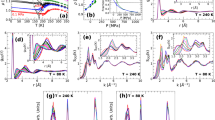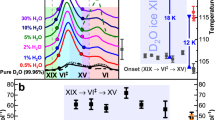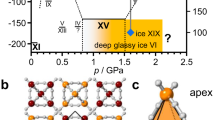‘Melting ice’ I at 77 K and 10 kbar: a new method of making amorphous solids (original) (raw)
- Letter
- Published: 02 August 1984
Nature volume 310, pages 393–395 (1984)Cite this article
- 2985 Accesses
- 1112 Citations
- 25 Altmetric
- Metrics details
Abstract
Amorphous solids are made mainly by cooling the liquid below the glass transition without crystallizing it, a method used since before recorded history1, and by depositing the vapour onto a cold plate2, as well as by several other methods3,4. We report here a new way—by ‘melting’ a solid by pressure below the glass transition of the liquid—and apply it to making a new kind of amorphous ice. Thus, ice I has been transformed to an amorphous phase, as determined by X-ray diffraction, by pressurizing it at 77 K to its extrapolated melting point of 10 kbar. At the melting point, the fluid is well below its glass transition. On heating at a rate of ∼2.6 K min−1 at zero pressure it transforms at ∼117 K to a second amorphous phase with a heat evolution of 42±∼8 J g−1 and at ∼152 K further transforms to ice I with a heat evolution of 92±∼15 J g−1. In one sample, ice Ic was formed and in another, existing crystals of ice Ih grew from the amorphous phase. Heating below the 117 K transition causes irreversible changes in the diffraction pattern, and a continuous range of amorphous phases can be made. Similar transformations will probably occur in all solids whose melting point decreases with increasing pressure if they can be cooled sufficiently for a transformation to a crystalline solid to be too slow.
This is a preview of subscription content, access via your institution
Access options
Subscribe to this journal
Receive 51 print issues and online access
$199.00 per year
only $3.90 per issue
Buy this article
- Purchase on SpringerLink
- Instant access to full article PDF
Prices may be subject to local taxes which are calculated during checkout
Additional access options:
Similar content being viewed by others



Structure and nature of ice XIX
Article Open access 26 May 2021
References
- Morey, A. W. The Properties of Glass 2nd edn, Ch. l (Reinhold, New York, 1954).
Google Scholar - Tammann, G. & Starinkewitsch, J. Z. phys. Chem. 85, 573–578 (1913).
Article Google Scholar - Secrist, D. R. & McKenzie, J. D. in Modem Aspects of the Vitreous State Vol. 3, 149–165 (Butterworths, London, 1964).
Google Scholar - De Carli, P. S. & Jamieson, J. C. J. chem. Phys. 31, 1675–1676 (1959).
Article ADS CAS Google Scholar - Bertie, J. E., Calvert, L. D. & Whalley, E. J. chem. Phys. 38, 840–846 (1963).
Article ADS CAS Google Scholar - Burton, E. F. & Oliver, W. F. Proc. R. Soc. A153, 166–172 (1938).
Google Scholar - Dowell, L. G. & Rinfret, A. P. Nature 188, 1144–1148 (1960).
Article ADS CAS Google Scholar - Bondot, P. C.r. hebd. Séanc. Acad. Sci. Paris 265, 316–318 (1967).
Google Scholar - Narten, A. H., Venkatesh, C. G. & Rice, S. A. J. chem. Phys. 64, 1106–1121 (1976).
Article ADS CAS Google Scholar - Mayer, E. & Brügeller, P. Nature 298, 715–718 (1982).
Article ADS CAS Google Scholar - Ghormley, J. A. & Hochandel, C. J. Science 171, 62–64 (1971).
Article ADS CAS Google Scholar - Gough, R. & Davidson, D. W. Can. J. Chem. 49, 2691–2699 (1971).
Article CAS Google Scholar - Kuriakose, A. K. & Whalley, E. J. Chem. Phys. 48, 2025–2031 (1968).
Article ADS CAS Google Scholar - Merrill, Leo J. phys. Chem. Ref. Data 6, 1205–1252 (1977).
Article ADS CAS Google Scholar - Cannon, J. F. J. phys. Chem. Ref. Data 3, 798–824 (1974).
Article Google Scholar - Stillinger, F. H. & Schweitzer, K. S. J. phys. Chem. 87, 4281–4288 (1983).
Article CAS Google Scholar - Bridgman, P. W. Proc. Am. Acad. Arts Sci. 76, 9–24 (1945).
Article CAS Google Scholar
Author information
Authors and Affiliations
- Division of Chemistry, National Research Council, Ottawa, Canada, K1A 0R9
O. Mishima, L. D. Calvert & E. Whalley
Authors
- O. Mishima
You can also search for this author inPubMed Google Scholar - L. D. Calvert
You can also search for this author inPubMed Google Scholar - E. Whalley
You can also search for this author inPubMed Google Scholar
Rights and permissions
About this article
Cite this article
Mishima, O., Calvert, L. & Whalley, E. ‘Melting ice’ I at 77 K and 10 kbar: a new method of making amorphous solids.Nature 310, 393–395 (1984). https://doi.org/10.1038/310393a0
- Received: 20 February 1984
- Accepted: 09 May 1984
- Issue Date: 02 August 1984
- DOI: https://doi.org/10.1038/310393a0
This article is cited by
Comments
By submitting a comment you agree to abide by our Terms and Community Guidelines. If you find something abusive or that does not comply with our terms or guidelines please flag it as inappropriate.